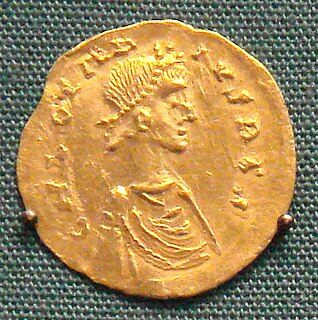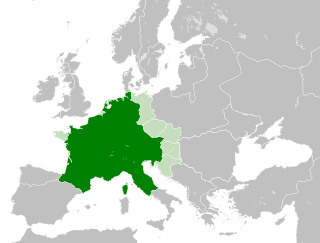
Charles Martel was a Frankish statesman and military leader who, as Duke and Prince of the Franks and Mayor of the Palace, was the de facto ruler of Francia from 718 until his death. He was a son of the Frankish statesman Pepin of Herstal and Pepin's mistress, a noblewoman named Alpaida. Charles successfully asserted his claims to power as successor to his father as the power behind the throne in Frankish politics. Continuing and building on his father's work, he restored centralized government in Francia and began the series of military campaigns that re-established the Franks as the undisputed masters of all Gaul. According to a near-contemporary source, the Liber Historiae Francorum, Charles was "a warrior who was uncommonly [...] effective in battle". Much attention has been paid to his success in defeating an Arab invasion in Aquitaine at the Battle of Tours. Alongside his military endeavours, Charles has been traditionally credited with a seminal role in the development of the Frankish system of feudalism.

Austrasia, was a territory which formed the northeastern section of the Merovingian Kingdom of the Franks during the 6th to 8th centuries. It was centred on the Meuse, Middle Rhine and the Moselle rivers, and was the original territory of the Franks, including both the so-called Salians and Rhineland Franks, which Clovis I conquered after first taking control of the bordering part of Roman Gaul, now northern France, which is sometimes described in this period as Neustria.

Chlothar II, called the Great or the Young, was king of Neustria and king of the Franks, and the son of Chilperic I and his third wife, Fredegund. He started his reign as an infant under the regency of his mother, who was in an uneasy alliance with Clothar's uncle King Guntram of Burgundy. Clothar assumed full power over Neustria upon the death of his mother, in 597; though rich this was one of the smallest portions of Francia. He continued his mother's feud with Queen Brunhilda of Austrasia with equal viciousness and bloodshed, finally achieving her execution in an especially brutal manner in 613, after winning the battle that enabled Chlothar to unite Francia under his rule. Like his father, he built up his territories by moving in after the deaths of other kings.

Neustria, was the western part of the Kingdom of the Franks.

Chlothar III was the eldest son of Clovis II, king of Neustria and Burgundy, and his queen Balthild. When Clovis died in 658, Chlothar succeeded him under the regency of his mother. Only a month beforehand, according to the near-contemporary Life of Eligius by the courtier Audoin (bishop) of Rouen, Saint Eligius had prophesied the death of Clovis, Balthild's downfall, and Chlothar's short reign.

Childeric III was King of Francia from 743 until he was deposed by Pope Zachary in March 751 at the instigation of Pepin the Short. Although his parentage is uncertain, he is considered the last Frankish king from the Merovingian dynasty. Once Childeric was deposed, Pepin the Short, who was the father of emperor Charlemagne, was crowned the first king of the Franks from the Carolingian dynasty.
Ebroin was the Frankish mayor of the palace of Neustria on two occasions; firstly from 658 to his deposition in 673 and secondly from 675 to his death in 680 or 681. In a violent and despotic career, he strove to impose the authority of Neustria, which was under his control, over Burgundy and Austrasia.
Under the Merovingian dynasty, the mayor of the palace or majordomo was the manager of the household of the Frankish king. The office existed from the sixth century, and during the seventh it evolved into the "power behind the throne" in the northeastern kingdom of Austrasia. In 751, the mayor of the palace, Pepin the Short, orchestrated the deposition of the king, Childeric III, and was crowned in his place.

Chilperic II, known as Daniel prior to his coronation, was the youngest son of Childeric II and his half-cousin, king of Neustria from 715 and sole king of the Franks from 718 until his death.

Francia, also called the Kingdom of the Franks, or Frankish Empire, was the largest post-Roman barbarian kingdom in Western Europe. It was ruled by the Franks during Late Antiquity and the Early Middle Ages. It is the predecessor of the modern states of France and Germany. After the Treaty of Verdun in 843, West Francia became the predecessor of France, and East Francia became that of Germany. Francia was among the last surviving Germanic kingdoms from the Migration Period era before its partition in 843.

Clovis IV (c.677–694/695) was the king of the Franks from 690 or 691 until his death. If the brief reign of Clovis III (675) is ignored as a usurpation, then Clovis IV may be numbered Clovis III.

Brunhilda was queen consort of Austrasia, part of Francia, by marriage to the Merovingian king Sigebert I of Austrasia, and regent for her son, grandson and great grandson.
Odo the Great, was the Duke of Aquitaine by 700. His territory included Vasconia in the south-west of Gaul and the Duchy of Aquitaine, a realm extending from the Loire to the Pyrenees, with the capital in Toulouse. He fought the Carolingian Franks and made alliances with the Moors to combat them. He retained this domain until his abdication in 735. He is remembered for defeating the Umayyads in 721 as they advanced down the Garonne through Aquitaine. He was the first to defeat them decisively in Western Europe. The feat earned him the epithet "The Great".

Childebert III, called the Just, was the son of Theuderic III and Clotilda and sole king of the Franks (694–711). He was seemingly but a puppet of the mayor of the palace, Pepin of Heristal, though his placita show him making judicial decisions of his own will, even against the Arnulfing clan. His nickname has no comprehensible justification except possibly as a result of these judgements, but the Liber Historiae Francorum calls him a "famous man" and "the glorious lord of good memory, Childebert, the just king." He had a son named Dagobert, who succeeded him, as Dagobert III but his wife was not Edonne, the invention of later fantasists. It is possible, though not likely, that Chlothar IV was also his son. He spent almost his entire life in a royal villa on the Oise.
Liber Historiae Francorum is a chronicle written anonymously during the 8th century. The first sections served as a secondary source for early Franks in the time of Marcomer, giving a short breviarum of events until the time of the late Merovingians. The subsequent sections of the chronicle are important primary sources for the contemporaneous history. They provide an account of the Pippinid family in Austrasia before they became the most famous Carolingians.

Clovis III was the Frankish king of Austrasia in 675 and possibly into 676. A member of the Merovingian dynasty, he was a child and his reign so brief and contested that he may be considered only a pretender. He is sometimes even left unnumbered and Clovis IV is instead called Clovis III. The only source for his reign is the contemporary Suffering of Leudegar.
Grimoald I (616–657), called the Elder, was the Mayor of the Palace of Austrasia from 640 to 656. He was the son of Pepin of Landen and Itta.
Theudoald was the mayor of the palace, briefly unopposed in 714 after the death of his grandfather, Pepin of Herstal. Then in 715 the nobility acclaimed Ragenfrid mayor of Neustria and Charles Martel mayor of Austrasia.
Ragenfrid was the mayor of the palace of Neustria and Burgundy from 715, when he filled the vacuum in Neustria caused by the death of Pepin of Heristal, until 718, when Charles Martel finally established himself over the whole Frankish kingdom.
The Battle of Soissons of 718 CE was the last of the great pitched battles of the civil war between the heirs of Pepin of Heristal. Since Pepin's death in December 714, his grandson and heir Theudoald, his widow Plectrude, his bastard son Charles Martel, his successor as mayor of the palace in Neustria Ragenfrid, and the new king Chilperic II had been waging a war for ascendancy. Though Ragenfrid and Chilperic had begun with successes and Plectrude and Theudoald were removed early, Martel turned the tide of war and eventually forced the surrender of all his opponents.














